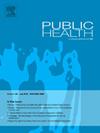胃癌的诊断途径和从症状到治疗的延迟:来自中国东南部一项横断面研究的发现
IF 3.2
3区 医学
Q1 PUBLIC, ENVIRONMENTAL & OCCUPATIONAL HEALTH
引用次数: 0
摘要
目的胃癌的预后与诊断分期密切相关。应高度重视减少胃癌患者从症状到治疗的延误。我们的主要目的是描述诊断途径和症状到治疗的延迟,并探讨患者延迟的预测因素。研究设计:回顾性横断面研究。方法在2021年11月1日至2022年10月31日期间,在中国南方两家三级甲等医院招募所有符合条件的首次诊断为胃癌的连续患者并进行访谈。结果共分析了533例胃癌患者。主要诊断途径为“有症状就诊”(82.7%)。患者间隔的中位数为21.5天,诊断间隔为5.0天,治疗间隔为10.0天。大约四分之一的患者有患者延误(24.1%)、诊断延误(22.1%)或治疗延误(28.9%)。家庭月收入最高(OR = 2.12, 95% CI: 1.13-3.97)、生活压力高/中等(OR = 1.87, 95% CI: 1.15-3.06)、有胃脘痛症状(OR = 2.06, 95% CI: 1.27-3.35)、首次就诊于乡镇医院/县医院(OR = 9.49, 95% CI: 3.29-27.42)或三级甲等医院(OR = 13.41, 95% CI: 4.40-40.84)与患者延误呈正相关。相比而言,在过去5年内曾有过胃癌筛查(OR = 0.44, 95% CI: 0.21-0.94)、有呕血/黑黑症状(OR = 0.23, 95% CI: 0.09-0.61)与患者延迟就诊呈负相关。结论绝大多数胃癌患者是有症状去看医生诊断的。从症状到治疗的延迟很常见,这突出了改善症状评估、寻求帮助行为和诊断途径的必要性。本文章由计算机程序翻译,如有差异,请以英文原文为准。
Diagnostic routes and symptom-to-treatment delays in gastric cancer: Findings from a cross-sectional study in southeastern China
Objectives
Prognosis of gastric cancer is strongly related to stage at diagnosis. Great attention should be given to reducing symptom-to-treatment delays in gastric cancer patients. We mainly aimed to describe diagnostic routes and symptom-to-treatment delays, as well as to explore the predictors of patient delays.
Study design
Retrospective cross-sectional study.
Methods
Between 1st November 2021 and 31st October 2022, all eligible consecutive patients with a first diagnosis of gastric cancer were recruited and interviewed at two Grade-A tertiary hospitals in southern China.
Results
A total of 533 gastric cancer patients were analyzed. The major diagnostic route was “visit the doctor with symptoms” (82.7 %). The median value was 21.5 days for patient interval, 5.0 days for diagnosis interval, and 10.0 days for treatment interval. About a quarter of patients had a patient delay (24.1 %), diagnosis delay (22.1 %), or treatment delay (28.9 %). Highest household monthly income (OR = 2.12, 95 % CI: 1.13–3.97), high/middle level of life stress (OR = 1.87, 95 % CI: 1.15–3.06), having symptoms of epigastric pain (OR = 2.06, 95 % CI: 1.27–3.35), first presentation to township hospital/county hospitals (OR = 9.49, 95 % CI: 3.29–27.42) or Grade-A tertiary hospital (OR = 13.41, 95 % CI: 4.40–40.84) were positively associated with patient delay. In contrast, ever had gastric cancer screening in the past 5 years (OR = 0.44, 95 % CI: 0.21–0.94), having symptoms of hematemesis/melena (OR = 0.23, 95 % CI: 0.09–0.61) were negatively associated with patient delay.
Conclusions
The majority of gastric cancer patients were diagnosed by visiting the doctor with symptoms. Symptom-to-treatment delays were common, highlighting the need to improve symptom appraisal, help-seeking behavior, and diagnostic pathways.
求助全文
通过发布文献求助,成功后即可免费获取论文全文。
去求助
来源期刊

Public Health
医学-公共卫生、环境卫生与职业卫生
CiteScore
7.60
自引率
0.00%
发文量
280
审稿时长
37 days
期刊介绍:
Public Health is an international, multidisciplinary peer-reviewed journal. It publishes original papers, reviews and short reports on all aspects of the science, philosophy, and practice of public health.
 求助内容:
求助内容: 应助结果提醒方式:
应助结果提醒方式:


